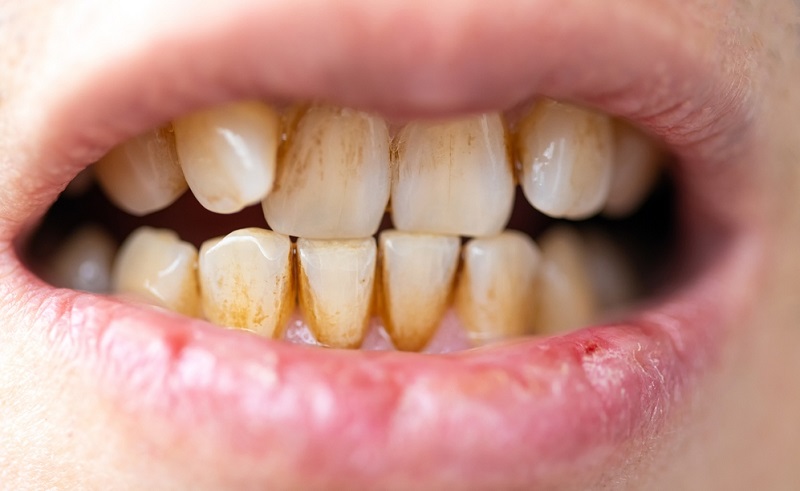Tartar Buildup: Causes, Prevention & What You Need to Know
Contents
- What is Tartar?
- What is The Effect of Tartar on Teeth and Gums?
- How to Prevent Tartar Buildup on Your Teeth?
- Brush your teeth twice a day using fluoride toothpaste.
- Brush your teeth before going to bed.
- Clean the interdental spaces with dental floss.
- Maintain healthy eating habits.
- Tobacco use, both smoking and chewing, is bad for your teeth.
- Where Does Tartar Originate?
- How can I tell whether I have tartar?

You understand the significance of brushing, flossing, and swishing with mouthwash regularly.
These actions, performed at the start and end of the day, can aid in the prevention of tartar accumulation on your teeth. But do you understand what causes tartar formation and why it occurs?
We take care of our teeth on a daily basis, just like we do the rest of our body. Brushing, flossing, and rinsing all assist to keep bacteria at bay and prevent tooth decay.
Tartar is a type of dental plaque made up of bacteria, proteins, and food byproducts that can accumulate on your teeth and cause cavities and other problems.
Continue reading this blog that will help you understand more about tartar buildup, how it affects your teeth and gums, and how to avoid it.
Many people wonder if there is a distinction between plaque and tartar, and it's a good question. Plaque and tartar buildup are both typical dental issues.
It has been observed that plaque accumulation can lead to tooth decay and gum disease. Tartar teeth are calcified plaque, which is a hard mineral deposit on teeth.
One indicator is a rough, bumpy line at the base of the teeth. Tartar on gums, on the other hand, can form below the gum line.
Tartar buildup on teeth can be removed by dental hygienists, and excellent oral hygiene can help prevent it from returning.
Knowing the facts can help you make better decisions about how to care for your teeth.
What is Tartar?
Even if you take exceptional home care of your teeth, bacteria will stay in your mouth. They combine with proteins and dietary wastes to form plaque, a sticky film.
This muck coats your teeth, penetrates your gums, and adheres to fillings and other dental procedures. Plaque contains microorganisms that can harm tooth enamel and cause cavities.
However, removing plaque regularly can help you avoid permanent tooth decay and gum disease. However, worse problems develop when plaque remains on your teeth and hardens into tartar.
Tartar buildup, also known as calculus, is hardened plaque on your teeth. Tartar on teeth is largely crystallised dead bacteria, with a trace of mineralized saliva proteins.
Tartar is composed of calcium phosphate, calcium carbonate, and magnesium phosphate. It can occur at and beneath the gum line and irritate gum tissues.
Tartar on teeth exposes more surface area to grow on and a stickier surface to connect to. This develops a high chance of more serious conditions like cavities and gum disease.
Tartar not only endangers the health of your teeth and gums, but it is also unsightly. Tartar absorbs stains easily because it is more porous.
What is The Effect of Tartar on Teeth and Gums?
Tartar can make brushing and flossing difficult. This can lead to cavities and tooth decay.
Tartar that forms above the gum line might be hazardous to your health. This is because the microorganisms in it irritate and destroy your gums. This may eventually result in degenerative gum disease.
This could eventually lead to degenerative gum disease. Gingivitis is the mildest kind of gum disease.
Brushing, flossing, using antimicrobial mouthwash, and visiting your dentist regularly may typically stop and reverse it.
Otherwise, it might deteriorate to the point where pockets form between the gums and teeth and become infected with bacteria.
How to Prevent Tartar Buildup on Your Teeth?
Only good oral hygiene routines can protect your teeth from plaque buildup and the diseases that it causes.
Here are some ideas for keeping your teeth and gums healthy:
1. Brush your teeth twice a day using fluoride toothpaste.
Fluoride on the tooth surface acts as a protective layer, reducing plaque production by bacteria in the mouth.
2. Brush your teeth before going to bed.
This is critical because the bacteria need a clear night to commence colonization and calculus deposit on tooth production.
Brush your teeth for two minutes, making sure to cover all regions.
After eating, rinse your mouth with fluoride-containing mouthwash.
3. Clean the interdental spaces with dental floss.
Tartar-forming germs are frequently found in the space between the teeth, and flossing aids in their removal.
Learn how to floss effectively without damaging your gums.
4. Maintain healthy eating habits.
Consuming foods high in sugar and starches regularly will facilitate the colonization of bacteria in your mouth.
Instead, eat well-balanced meals with plenty of roughage, which naturally cleans the teeth.
5. Tobacco use, both smoking and chewing, is bad for your teeth.
The enamel becomes discoloured, the teeth become more prone to infections, and the gums become more readily inflamed.
The enamel leaching is harmful to a smoker.
Where Does Tartar Originate?
Certain meals can cause tartar formation on the gums and teeth to increase.
Calculus on teeth is an accumulation caused by bread, spaghetti, and other starchy meals that might feel like rough areas on your teeth. Sugary drinks, such as soda and sweet tea, can also contribute to tartar formation on the teeth and gums.
You may also be surprised to learn that the toothpaste you use may not be effective in preventing tartar buildup on your teeth.
Certain brushing and flossing methods may also be unsuccessful at removing tartar.
Unhealthy habits such as smoking can also cause tartar to build up on your teeth and gums.
How can I tell whether I have tartar?
Tartar is a mineral deposit that is visible above the gum line, as opposed to plaque, which is a colourless coating of germs.
Calculus teeth in the mouth feel like a hard substance that brushing alone will not eliminate. It also irritates the gums, resulting in inflammation, bleeding, and, ultimately, gum disease.
Tartar on gums that form below the gum line can create elevated swellings that bleed. If not removed, buildup above the gum line appears yellow or tan and develops larger.
It could be brown or black beneath the gum line. Only dentists can successfully remove tartar accumulation on teeth using a procedure known as scaling.


